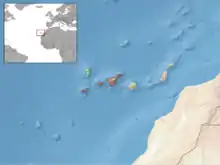West Canary skink
The West Canary skink (Chalcides viridanus), also known commonly as the Canaryan cylindrical skink, East Canary Islands skink, the Tenerife skink, and lisa dorada in Spanish, is a species of lizard in the family Scincidae. The species is endemic to the Canary Islands.
| West Canary skink | |
|---|---|
.JPG.webp) | |
| Scientific classification | |
| Kingdom: | Animalia |
| Phylum: | Chordata |
| Class: | Reptilia |
| Order: | Squamata |
| Family: | Scincidae |
| Genus: | Chalcides |
| Species: | C. viridanus |
| Binomial name | |
| Chalcides viridanus (Gravenhorst, 1851) | |
 | |
| Synonyms[2] | |
| |
Habitat
The natural habitats of C. viridanus are temperate forest, temperate shrubland, subtropical or tropical dry shrubland, Mediterranean-type shrubby vegetation, temperate grassland, rocky areas, rocky shores, sandy shores, arable land, pastureland, rural gardens, and urban areas. It is found at altitudes up to 2,000 m (6,600 ft).[1]
Description
C. viridanus may reach a total length (including tail) of about 18 cm (7.1 in).
Behavior
C. viridanus is active during the day and at dusk. Both its life in nature and its requirements in a terrarium are very similar to those of the Gran Canaria skink.
Reproduction
C. viridanus is viviparous.[2]
Geographic range
C. viridianus is found on the following Canary Islands: Tenerife, El Hierro, Roque de Garachico, and Roque de Agna.
Sources
(listed chronologically)
- Brown RP, Thorpe RS, Báez M (1991). "Parallel within-island microevolution of lizards on neighbouring islands". Nature 352: 60–62.
- Brown RP, Thorpe RS, Báez M (1993). "Patterns and causes of morphological population differentiation in the Tenerife skink, Chalcides viridanus ". Biological Journal of the Linnean Society 50 (4): 313–328.
- Brown RP, Pestano J (1998). "Phylogeography of Canary Island skinks inferred from mtDNA sequences". Molecular Ecology 7: 1183–1191.
- Brown RP, Campos-Delgado R, Pestano J (2000). "Mitochondrial DNA evolution and population history of the Tenerife skink Chalcides viridanus ". Molecular Ecology 9: 1061–1069.
References
- Miras JAM, Pérez-Mellado V, Martínez-Solano I (2009). "Chalcides viridanus ". The IUCN Red List of Threatened Species 2009: e.T61490A12480456. https://dx.doi.org/10.2305/IUCN.UK.2009.RLTS.T61490A12480456.en. Downloaded on 29 April 2020.
- Species Chalcides viridanus at The Reptile Database www.reptile-database.org.
Further reading
- Boulenger GA (1887). Catalogue of the Lizards in the British Museum (Natural History). Second Edition. Volume III. ... Scincidæ .... London: Trustees of the British Museum (Natural History). (Taylor and Francis, printers). xii + 575 pp. + Plates I-XL. (Chalcides viridanus, new combination, p. 402).
- Gravenhorst JLC (1851). "Über die im Zoologischen Museum der Universität Breslau befindlichen Wirtelschleichen (Pseudosaura), Krüppelfüssler (Brachypoda) und einige andere, denselben verwandte Reptilien aus dem Zünften der Schleichen und Dickzüngler ". Nova Acta Academiae Caesarae Leopoldina Carolinae Germaninicae Naturae 23 (1): 291–394. (Gongylus viridanus, new species, pp. 348–350 + Plate XXXV, figures 1–6). (in German).
